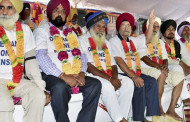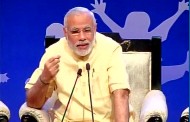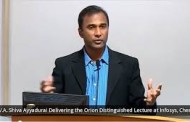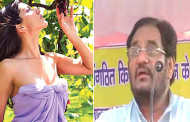New Delhi: Amid a stand-off over ‘One Rank, One Pension’ (OROP), the agitating ex-servicemen on Saturday met Defence Minister Manohar Parrikar and discussed modalities of government’s proposal for resolution of the issue.
After the meeting, the ex-servicemen announced that the government has approved the OROP concept in principle.
Talking to journalists, spokesman of the protesting veterans, Major General (Retd) Satbir Singh, said they have told the government that there is nothing like voluntary retirement (VRS) in defence. Only the concept
After the meeting, the ex-servicemen announced that the government has approved the OROP concept in principle.
Talking to journalists, spokesman of the protesting veterans, Major General (Retd) Satbir Singh, said they have told the government that there is nothing like voluntary retirement (VRS) in defence. Only the concept of premature retirement exists and those who opt it also get pension, added Singh.
Saying that the meeting between the delegation and Parrikar took place in an amicable environment, Singh said that the Defence Minister has understood their point that all those veterans who sought premature retirement should get OROP and those getting disability pension should also get it.
“By the grace of God, OROP has been approved by the government,” Singh said at a press conference at Jantar Mantar.
“The third bone of contention is still there, which is when the revision of pension should take place. While the government is saying it should be five years, we have said that this will kill the definition of One Rank, One Pension. The minister has said a committee will be formed on this,” he said.
He announced that the government has proposed making one-man commission (probably a retired judge) to look into the demand of veterans. However, Singh said that they have suggested to constitute a five-member committee (which should include three ex-veterans, one serviceman, and one retired judge).
The delegation has asked the government to set a timeframe of 15-30 days to resolve the issue.
Also Read: OROP: Ex-servicemen meet Manohar Parrikar; govt to make announcement
With their agitation at Jantar Mantar seeking early implementation of OROP entering the 83rd day today, retired personnel of the armed forces made it clear that they want the concept of OROP to be executed properly, and no senior should get lesser pension than a junior at any time.
Also Read: OROP: Ex-servicemen meet Parrikar, discuss modalities
The Defence Ministry has called a press conference at 2.30 pm. However, the subject of the press conference has not been disclosed.
It is understood that a draft proposal on OROP was circulated at a RSS meeting yesterday which envisaged commencement of the scheme from July 2014, besides revision of pension every five years.
According to the draft, the basis for the implementation of the scheme would be 2013 and arrears would be paid in four installments.
Close to 26 lakh retired servicemen and over six lakh war widows stand to be immediate beneficiaries of the scheme, which envisages a uniform pension for the defence personnel who retire in the same rank with the same length of service, irrespective of their date of retirement.
Currently, the pension for retired personnel is based on the Pay Commission recommendations of the time when he or she retired. So, a Major General who retired in 1996 draws less pension than a Lt Colonel who retired after 1996.
Nepal Airlines, the national carrier of the Himalayan country, resumes flight to Mumbai from 4th September, after exiting nine years ago, with two direct weekly flights to Kathmandu.
The first flight from Kathmandu consisted of 52 passengers and from Mumbai it flew 54 passenegrs including an infant in its two brand new Airbus A320s,
As a promotional offer, it is offering a buy-two-get-one offer at Rs 14,000 for a round-trip ticket. The offer is valid through September, the airline said.
“We are reentering Mumbai from tomorrow with two weekly flights (Mondays and Fridays). We want to increase the frequency to three soon. The Mumbai entry follows resumption of our successful operations from Delhi from February and from Bangalore from September 1,” airlines’ commercial director Saroj Kasaju told PTI.
The airline will be operating from the new T2 terminal of Mumbai airport.
Kasaju said the airline was operating from these three cities till 2006 when it had to quit because of unavailability of aircraft.
Recently the airline bought two brand new Airbus A320s, he said, adding the airline is also planning to order wide-body A330s in a year.
The airline is making money despite having only four planes (two Airbus 320s and two Boeing 757s) and being fully owned by the government unlike its counterpart here Air India which has been bleeding for years. Prior to 2006 Nepal Airlines was also operating from Kolkata and Patna.
“We are also keen to add Kolkata to our network shortly, but it is too early to say anything more concrete on that as we are still studying the market,” Kasaju said.
He said the airline is filling up to 70-80% seats from both New Delhi and Bangalore (Tuesdays and Saturdays).
Kathmandu is served by 26 international airlines, including Air India and IndiGo (Spicejet discontinued operations after the earthquake and will resume from December), while Nepal Airlines connects 7 international destinations like Bangkok, Hong Kong, Dubai, Doha, apart from the three Indian cities, Kasaju said, adding it will be flying to Canton in China from next year.
When asked about the passenger profile from Nepal, he said almost 30% each are Nepalese and Indians while the rest are international passengers.
Kasaju said most of the Indians flying into Nepal are pilgrims (Kailash-Mansarovar being the top destinations) and MICE travellers.
The airline has appointed Bird Group as its sole general sales agent. The airlines’ website is not enabled to sell tickets online, he said.
BEIJING—With an extravagant parade, President Xi Jinping made the most forceful display yet of China’s expanding military muscle and his own grip on power, after weeks of rising concern about economic challenges and disunity at the top.
The spectacle featuring some of China’s newest fighter jets, missiles, drones and helicopters achieved its principal goal, offering a domestic audience a carefully choreographed show of national strength and Communist Party unity.
But the parade marking the surrender of Japanese forces at the end of World War II also cast a spotlight on China’s deepening divisions with the U.S. and its allies: No major Western nations sent leaders or troops to an event that appeared designed to discredit modern-day Japan and showcase Chinese firepower.
In further evidence of China’s growing military capabilities and ambitions, Pentagon officials said on the eve of the parade that five Chinese navy ships were operating off the coast of Alaska, where President Barack Obama has been visiting this week and where such activity hadn’t been seen before.
r. Xi tried to strike a conciliatory note in a speech before the parade, which comes three weeks before he heads to the U.S. on a visit already clouded by differences on alleged cyberattacks on the U.S., and China’s island-building in the South China Sea.
“We Chinese love peace,” Mr. Xi said from a stand atop the Gate of Heavenly Peace, overlooking Tiananmen Square.
“No matter how much stronger it may become, China will never seek hegemony or expansion. It will never inflict its past suffering on any other nation.”
He also announced that China’s People’s Liberation Army would be cut by 300,000 troops—the largest reduction in more than a decade of armed forces estimated to number around 2.3 million. A Defense Ministry statement later said the reductions would be done by the end of 2017 and would target units with outmoded equipment and noncombat personnel.
Still, many Western officials and analysts said it was the display of weaponry—including aircraft-carrier-based fighter jets and missiles they believe are designed to prevent the U.S. from intervening in a conflict in Asia—that defined the event, rather than the announcement of troop cuts.
“Displaying cutting-edge military hardware and announcing personnel cuts is not really a contradiction,” said Rory Medcalf, head of the National Security College at the Australian National University.
“In fact, it’s consistent—human waves of infantry are not going to win the next war in Asia,” he said. “Thinning the ranks of low-skilled soldiers will free up resources for high-tech capabilities like cyber and hypersonic missiles, and of course naval modernization.”
Among the high-tech armaments being displayed for the first time was the DF-21D antiship ballistic missile, which many experts call a “carrier-killer” because it is designed specifically to target approaching U.S. aircraft carriers.
The parade also showed for the first time the DF-26 intermediate-range ballistic missile, China’s first one capable of striking a U.S. naval base in Guam with a conventional warhead from a launcher on the mainland.
The U.S., which was represented at the parade by its ambassador in Beijing, had repeatedly urged China to hold a forward-looking event that promoted reconciliation. The U.S. Embassy didn’t immediately respond to a request for comment.
Congressman Randy Forbes, a Virginia Republican who heads a House committee on sea power, said in a statement after the parade: “It seems significant that while the United States marked the end of the war with a solemn ceremony, China chose to showcase its growing military might and the new weapons it has built to menace its neighbors. It seems increasingly clear that China intends to undermine the post-1945 order that has brought peace and prosperity to Asia.”
Japan’s Prime Minister, Shinzo Abe, didn’t attend. His top government spokesman, Chief Cabinet Secretary Yoshihide Suga, said Thursday: “We have conveyed to China our position that we would like it to adopt a future-oriented stance instead of placing a spotlight on the past.”
She only became queen by a twist of fate but now, aged 89, Elizabeth II is about to become Britain’s longest-serving monarch in a reign spanning the post-war era to the digital age.
A constant in an ever-changing world, she is at the height of her prestige and “embodies the history of the 20th century”, according to historian Kate Williams.
The queen has met most of the major figures in recent history, from India’s first prime minister Jawaharlal Nehru to Japanese emperor Hirohito and French general turned statesman Charles de Gaulle.
South Africa’s anti-apartheid icon Nelson Mandela called her “my friend”, while her reign has seen the construction and the destruction of the Berlin Wall.
The sprawling British empire of the Victorian era, on which it was said that the sun never set, has shrunk to a few remnants during her reign. Most recently, Hong Kong was handed over to China in 1997.
Yet even in far-flung parts of the world, “when people refer to the queen they almost always mean our queen,” said John Major, one of the 12 prime ministers to have held office during her reign.
Britain’s slender republican movement condemns a system based on inherited privilege. But for many, the queen is a mainstay in a multi-ethnic country increasingly riven by regional divisions, including in Scotland, which voted against independence last year.
Elizabeth Alexandra Mary Windsor’s birth on April 21 1926 was a relatively minor event for a world teetering between two world wars and just three years away from the Great Depression.
The curly-haired “Lilibet” was destined for marriage, not the throne.
But after reigning for just 325 days, her childless uncle Edward VIII abdicated in 1936 to marry Wallis Simpson, a twice-divorced American.
Princess Elizabeth’s father inherited the crown as George VI and she suddenly became heir to the throne.
When the young Elizabeth and her sister Margaret had to move to Buckingham Palace, she asked her nanny: “What — you mean forever?”
On her 21st birthday, she vowed to spend her life serving her country.
On November 20, 1947 she married Philip — a distant cousin who renounced his titles as prince of Greece and Denmark and his career in the Royal Navy to be with her. She has described him as “my strength and stay”.
When George VI died at the age of 56 in 1952 she became queen aged just 25 and with two young children: Charles (born in 1948) and Anne (1950). Two others came later — Andrew (1960) and Edward (1964).
Her role is highly ceremonial and she remains above the fray of politics.
Every year, she reads out the programme of the government of the day at the State Opening of Parliament.
Her voice remains neutral and high-pitched, even when the proposals include measures she is suspected of opposing, such as banning the traditional sport of fox-hunting.
“Ma’am” as her subjects address her, also presides over the Commonwealth composed of 54 members, including 15 former colonies where she is still the sovereign, such as Australia and Canada.
Usually dressed in bright colours so as to be seen by everyone despite her petite size, she has carried out some groundbreaking and exotic visits including to China, the Vatican and the Cocos Islands.
“The primary role of the monarchy is to sell the British brand and the queen is very good at it,” said royal biographer Robert Jobson
Despite the widespread respect she now commands, her reign has had plenty of ups and downs.
In 1981, her heir Charles married Diana in a fairytale wedding that quickly turned sour despite the birth of their two sons William and Harry.
She called 1992 her “annus horribilis” when the marriages of three of her children — Charles, Anne and Andrew — fell apart and her castle in Windsor was badly burnt in a fire.
In 1997, the queen was accused of being out of touch as her subjects wept for the death of Diana in a Paris car crash while she remained at her country estate in Scotland for days before coming to acknowledge the crowds of mourners in London.
In the two decades since, though, there has been a remarkable turnaround for the monarchy — helped along by a powerful communications machine.
The queen has cut palace budgets and William’s marriage to commoner Kate Middleton has helped create the image of a more modern monarchy.
Her 66-year-old son Charles is increasingly taking her place at public engagements but experts agree that she will most likely hold on to the end and not follow her Dutch and Spanish royal peers by abdicating.
“It’s possible going forward if she wasn’t feeling particularly well or was physically infirm that her son Prince Charles could act as regent,” said Jobson. “Nobody is saying she would abdicate.”
She has visited 132 countries, posed for 139 portraits and given thousands of speeches, though never an interview. Her private life is largely a mystery.
The monarchy’s official website says she still goes horse riding and has 30 Corgi dogs in her palaces.
Rare indiscretions from palace insiders have revealed her love of the ”Racing Post” newspaper’s horse racing tips, a Dubonnet and gin before lunch and crossword puzzles.
800 students and 60 teachers from various schools in Delhi interacted with Prime Minister Narendra Modi on Friday along with students from across the country who have excelled in various activities. “As a part of Teachers’ Day celebrations, tomorrow at 10 AM I will attend a programme very close to my heart – interaction with school children,” Modi tweeted on Thursday night.
Here are the live updates:
Question from a student of Jawahar Navodaya Vidyalaya Mungeshpur, New Delhi: You have a unique sense of dressing. Modi kurta has become a fashion statement. How did you get the idea of promoting Indian wear?
PM Modi replies: There is a notion that I have a fashion designer. Let me tell you I don’t have any fashion designer for myself. I have designed this half-sleeve kurta myself, I feel comfortable in it, there is no fashion designer involved.
Question from a student of Kendriya Vidyalaya, Janakpuri, New Delhi: How should we make our parents understand not to force their ambitions on their kids?
PM Modi replies: My parents would have celebrated even if I had been a clerk. Parents should not force their dreams on their children Parents should try to take out some time from their busy schedule for their wards.
Question from a student in Srinagar, Jammu and Kashmir: When you were a student what fascinated you the most – your classroom learning or experiments outside the classroom?
PM Modi replies: I was not that good in studies. But I was a keen observer. You get a sense of priority in a classroom which helps you plan things.
Question from a student in Bokaro, Jharkhand: What do you think is a recipe of success?
PM Modi replies: There is no recipe for success. We should never let failure to affect us, we should actually learn from it and try to improve always. I suggest you all read a book – Polyana – it’s on positive thinking.
Question from a student in Bengaluru: Why is there a lack of qualified teachers in the country?
PM Modi replies: It’s not that the country lacks qualified teachers. There are plenty of them. People who have excelled in their respective fields should come forward to commit at least 1 hour a week to train and teach children.
Question from a student in Tirunelvelli: Sir, I would like to serve my country. Can you please guide me in what ways I can work for the country?
PM Modi replies: We can serve through little steps. Saving energy is also like service to nation.
Question from a student in Patna: What message do you want to give to lakhs of students aspiring to be an engineer?
PM Modi replies: I am working to bring in a change in some rituals that schools follow. Character Certificates should be replaced with Aptitude Certificate.
Question from a group of students in Bengaluru: Given the condition of waste management in the country, which is highly unorganised. Sir, what are the main challenges in Swachh Bharat Abhiyan?
PM Modi replies: When I first thought about the scheme, I felt it was a huge challenge. Swachh Bharat Abhiyan is not a government project, it is a thought process. I assure you things will change through small steps.
Question from a student in Panaji, Goa: Which are your favourite games?
PM Modi replies: Everyone knows what game politicians play, quips PM Modi. Kabbadi and Kho-Kho were my favourite games in village. I washed my clothes at village pond, later, swimming became my hobby.
Question from a student in Dehradun: Digital India is a unique scheme but several areas of the country are still without electricity, how will Digital India will be successful?
PM Modi replies: You are right, there are 18,000 villages still without electricity. I announced on 15 August that 1000 villages would soon have electricity connection. We are working towards it, full electrification will soon be achieved
Question from a student in Manipur: To be a good leader what qualities should I nurture?
PM Modi replies: There is a perception in the country that politics is bad. People are afraid to join politics. We are living in a democratic set up. It is important that more good people come into politics. You should build leadership qualities.
Question from a student in Nizamabad, Telangana: Who has been the biggest influence on you sir?
PM Modi replies: If our mind is receptive, we tend to absorb various things. I liked all my teachers and my mother had a great influence on me. I read many books on Swami Vivekanand, which had a great impact on me.
Prime Minister Narendra Modi finishes his address. Interaction with school children from across the country begins now
* We don’t want our students to be robots. The government has launched a new website to identify the talent of students: PM Modi
* Not all recognition can be monetary. Our government is trying to recognise the contribution of teachers: PM Modi
* It’s not a rule that only experts can be teachers. Even the most ordinary and poor can be inspiration to students: PM
* Not many of us lived at the time of Dr. Radhakrishnan, but we did interact with Dr.Kalam who wanted to be remembered as a teacher: PM
* Children spend more time with teachers than at home: PM
* A true teacher never retires: PM
* Sometimes I feel that teachers should write about some students who left a mark on them, it will show their involvement: PM Modi
* I will students are the image of teachers: PM Modi
* PM at Manekshaw auditorium (Delhi), releases commemorative coin and a circulation coin in honor of Dr Radhakrishnan.
* PM Modi launches the website for Kala Utsav, to promote art in education.
Dr. V.A. Shiva Ayyadurai argues that innovation in India cannot take place in any substantive way until the feudal culture persistent in its scientific institutions is addressed. His observations come from being an insider serving at the top-most scientific position in 2009 at the Council of Scientific and Industrial Research (CSIR). Dr. Shiva was appointed in 2009 by the Prime Minister of India to the highest scientific position attainable in India within CSIR to unleash innovation. As an insider, he observed many core dysfunctions, which he published in an honest report. The contents of that report were released to the press for which he was subsequently dismissed and threatened, leading to him having to flee India. On the Innovation Demands Freedom website, he shares the details of this journey.
Dr. V.A. Shiva Ayyadurai’s central critique and complaint of India’s scientific infrastructure and subculture concerns the blockages within India’s social infrastructure to rising innovators and entrepreneurs based on a feudal hierarchy. Emigrating to the United States at age seven in 1970, Dr. Shiva returned decades later in 2009 to India on a Fulbright to study the links of eastern medicine with modern biology. Concluding his year-long Fulbright grant, Dr. Shiva was asked to join the CSIR where he found himself at odds and at the center of controversy concerning the council’s leadership. Issuing a report to deploy innovation across India, VA Shiva identified and critiqued India’s backward feudal hierarchy as a detrimental barrier to innovation. Issuing a direct critique of the CSIR’s insufficiencies insofar as leading toward the creation of an India with greater innovative freedom and integrity of scientific organization, VA Shiva was dismissed from the Council and returned to MIT where he has since written compellingly concerning the power of freedom of thought and scientific inquiry that must necessarily exist alongside a supportive infrastructure for the generation of innovation.
Know the Truth:
What did Dr. V.A. Shiva Ayyadurai Accomplish in India?
While at CSIR, Dr. V.A. Shiva Ayyadurai spoke to nearly 1,500 scientists and soon found strong echoes of agreement that CSIR was in fact an organization corrupted by its own management, suffocating ingenuity and innovation and suppressing the voice of India’s scientific community from achieving its largest potential. Seventy years following Britain’s occupation of India- there have been zero Nobel prize winners in India in any category of science or medicine and even prior to that. Ironically, under British occupation, two Indians received Nobel Prize awards. Facing public outcry concerning lack of performance of India’s scientific facilities and of India’s scientific community at large, Dr. Shiva was brought into the organizational fold and hired at least in theory to ignite a sustained trajectory of innovation in India. Sadly enough, however, the internal agenda of the CSIR’s management had in reality only brought in Dr. Shiva as a palliative solution to a tired and corrupt organizational infrastructure, plagued by nepotism and failure to deliver on its organizational promises and intentions.
Find Your Way:
The Honest Report
Within three months of his extended stay in India, Dr. V.A. Shiva Ayyadurai had organized a new model for India’s innovation, as approved by India’s Former Stock Exchange Board chairman and as hailed by “nearly all the scientists across India.” Dr. Shiva’s model for innovation was based on driving hands-on entrepreneurship, such as encouraging scientists to find real customers for their laboratory innovations. Recall the original intention of CSIR was to be a translational institute, converting ideas to tangible products for the Indian masses. Dr. Shiva’s report provided a bold new model for implementing that vision, which had not existed in the 70-year history of CSIR.
In spite of the acceptance of his model among scientific scholars, the CSIR did not permit Dr. V.A. Shiva Ayyadurai to deploy his model.
Dr. Shiva comments:
“(Doing so) would mean they would have to demonstrate more transparency, openness, and meritocracy within a fundamentally feudal organization.”
(Source: Innovation Demands Freedom)
Meanwhile, Dr. Shiva’s own boss was under investigation for potentially embezzling 35 million dollars. During this investigation in July of 2009, half of the CSIR central headquarters sustained a major fire in which a bookkeeper who would have been an important witness in the investigation was also killed.
Be the Light:
The Effect of Distributing an Honest Report
Following the dissemination of an honest report to India’s 4500 scientists, within hours, Dr. V.A. Shiva Ayyadurai’s email was shut-down and he was dismissed, evicted from his house, and issued multiple threats to his life, forcing his having to leave India. Dr. Shiva exited India through Nepal, escaping the crushingly negative feedback- all for just writing a singularly accurate report. One of India’s most eminent scientists, PM Bhargava, a former chief scientific advisor to Indira Gandhi, wrote to the Prime Minister of India, urging him to meet with Dr. Shiva.
The long arduous route taken by VA Shiva while fleeing New Delhi in India.
Following the events of Dr. V.A. Shiva Ayyadurai’s persecution, there is now a growing anti-corruption movement, spurring people to become more emboldened in demanding transparency, the fundamental thesis of Dr. Shiva’s report. Back in the United States, Dr. Shiva has now launched the Innovation Corps, which looks to spur innovation any where, any time, by any body. Innovation Corps recognizes that be it institutions such as CSIR or inner cities such as Newark, NJ, where VA Shiva invented the first email system, millions of creative people exist, who simply need the right infrastructure so their ideas can be translated to tangible innovations.
Chennai, India: Reports have surfaced regarding security officials of Chennai Metro Rail Limited who allegedly ordered a Sikh man to remove his dastar (turban) inside the metro on Tuesday 1 September 2015.
Tandeep Singh, a resident of Chennai, decided to take his first ride on the metro when he was allegedly asked to remove his dastar (turban) at the Vadapalani station. Despite telling the officials that removing the dastar went against his faith and he cannot be asked to do it, the guards said that those were the instructions given to them.
“This is not the first time something like this has happened to me, unfortunately. Let me tell you I’ve traveled in and around USA as well and I’ve never been asked to take my turban off. However this ridiculous request is made only in India. I’m shocked and appalled by this. I thought Chennai has actually changed and finally we are moving on as a city and be more accepting of different cultures and races.”
“I had to be quite stern with him. I asked him to get the supervisor. Then he relented and let me go,” he added on the post.
Singh expressed his concern over such incidents stating “I don’t blame the security guy for this instance, it is nothing but pure ignorance. CMRL (Chennai Metro Rail Limited) you are at fault here, you need to educate your staff more about such issues. I was in two minds to throw a raging fit there and make a scene. I refrained from doing so, because that is what my culture, my faith teaches me to do. To be patient and understanding with the ignorant.”
“This issue must be looked into right away. It is bad enough Chennai as a city has such an unfriendly reputation from most of India. It’s time to be more welcoming and accepting,” he added.
Chennai Metro Rail Limited are understood to have contacted and apologised to Singh, after the incident came to light. An official said that they were sorry for the incident and would look into the issue. However the official response to Tandeep Singh is unknown.
While Europe’s politicians flounder in the face of an unprecedented wave of refugees and migrants seeking shelter — many of them from war-torn Syria — some individuals have decided to take matters into their own hands.
Using digital means, they are taking practical steps to offer desperate men, woman and children a place to stay in their own homes, or seeking to pressure their own governments into offering sanctuary to more of those in need.
In Iceland, author and professor Bryndis Bjorgvinsdottir has set up a Facebook page to call for her country’s government to increase the number of refugees it was planning to accept from a reported 50 — prompting a big response and wide media interest.
And in Germany, a website has been running for months which aims to match offers of accommodation in private homes — ideally shared rental apartments — across the country with individual refugees in need of a place to stay.
The website, Refugees Welcome (Fluechtlinge Wilkommen,) has already placed dozens of refugees who otherwise might be placed in overcrowded migrant centers or struggle to put a roof over their heads at all.
Such direct action couldn’t be more needed.
Migrants are pouring over Europe’s borders in record numbers this year, according to the EU border agency Frontex, many of them fleeing conflict in Syria, Iraq and Afghanistan. In July alone, a record 107,500 were detected at EU borders, it said.
‘Refugees are our future spouses, best friends’
In Reykjavik, Bjorgvinsdottir’s inspiration came from a friend who posted a status update on Facebook — addressed to Iceland’s Minister of Welfare Eyglo Hardar — saying he wanted to take five Syrian refugees into his own home, she said.
With just that gesture, her friend pointed out, the number Iceland took in could increase to 55, Bjorgvinsdottir told CNN’s “The World Right Now.”
Struck by his idea, she thought that she could offer to pay for the flights. “Then I got this idea that maybe more people want to join in and give food or clothes or even offering their houses or extra bedrooms — and I did that just to see how much we could raise the number from maybe 50 to 100 or 200,” she said.
The idea took off and the page already has 12,000 members, Bjorgvinsdottir said — no mean feat given the country’s population is only about 300,000. Proportionately, that equates to some 12 million people signing up in the United States.
A post on her Facebook page says, “Refugees are human resources, experience and skills. Refugees are our future spouses, best friends, our next soul mate, the drummer in our children’s band, our next colleague, Miss Iceland 2022, the carpenter who finally fixes our bathroom, the chef in the cafeteria, the fireman, the hacker and the television host. People who we’ll never be able to say to: ‘Your life is worth less than mine.'”
Bjorgvinsdottir hasn’t yet been able to sort through the comments posted on the page to calculate how many offers of places to stay there are. But with the help of volunteers she hopes to pass that information on to the government in the near future, in the hope it can be put to concrete use.
The war in Syria has been dragging on for years, she said, and Icelanders don’t understand why they are not seeing more refugees being given sanctuary in their country.
“People just really want to help and they really want to see actions — and actions taken immediately, right now, because time matters a lot in this situation,” she said.
Inspired by the Icelandic example, a U.S. group has also been set up on Facebook, called “Americans Supporting Syrian Refugees: Open Homes, Open Hearts.”
Berlin host: ‘Fantastic’ experience to help a migrant
In Germany, Katie Griggs, a Briton who’s been living in Berlin for several years, is one of those who responded to the call of Refugees Welcome and registered with the website in March.
She and her husband own their apartment, so couldn’t provide an apartment share, but could offer a guestroom for emergency accommodation.
Just a few weeks after they signed up, they welcomed a pregnant woman from Nigeria into their compact, two-bedroom flat in Berlin’s hip Kreuzberg district, Griggs told CNN by phone from Berlin.
The woman, whom Griggs refers to as Alyssa on her blog to safeguard her privacy, had been referred to Refugees Welcome by another group in Berlin which helps trafficked women. Realizing she was pregnant and in a worsening situation, Alyssa had left Greece — where she’d spent two years after traveling from Nigeria — and made another perilous overland journey to Germany in search of help, Griggs said.
“Of course we had worries and then other people throw worries at you,” said Griggs of her initial reaction on being asked to host Alyssa in May. Those concerns included questions over the penniless 24-year-old’s health and their own personal security.
But, Griggs said, “The actual experience was brilliant, it was absolutely fantastic. We got to learn about Africa just in our own living room. She was lovely, she was so positive the whole time, even though she was on her own, a pregnant woman.
Alyssa told how she’d left school at 11 because there was no money to pay for her education, Griggs said. Griggs tried to help their guest with German and with learning about the baby she’s expecting in November.
“But she also gave us lots back — we learned about Nigerian food, about Nollywood, she would do a bit of dancing for us, teach us about African music and culture,” said Griggs.
Six weeks later, Alyssa felt able to lodge a formal asylum claim and was whisked off by train to a center in western Germany the same day, clutching her meager belongings in a plastic bag. Since then, Alyssa has stayed in touch by phone — and Griggs says she misses having her in their home.
Berliners lend a Syrian refugee a bike
Horrified by the images she’s seen of conflict and the tragic deaths of Syrian refugees seeking to reach Europe, Griggs has also tried to help Syrian refugees in Berlin.
She signed up to a Berlin-based Facebook bicycling group set up by a Syrian refugee, Monis Bukhari, to help fellow Syrians arriving in the city adjust to their new lives.
It asks Berliners to lend bikes for one-day bike tours, so that the newly arrived refugees can meet fellow residents of the city, German or other nationalities, stay active and get to know their way around — all helping them to integrate into the community.
The cycling group brings together mostly people aged 25 and under, Bukhari said, with similar interests — important when so many of the Syrians coming to Germany are young.
And it’s not a one-way street.
Bukhari, who arrived in Berlin two years ago and has recently been granted a German passport, is using Facebook to organize a “Thank you Germany” event on October 10, in which Syrians will hand out flowers randomly to Germans at stations across the country and play music for free for their enjoyment.
Bukhari, who’s part of a wider volunteer group within Germany called Syrian House which seeks to help new arrivals navigate German laws and bureaucracy, told CNN that the event has a dual purpose.
“First of all, we as Syrians, we think that German people deserve to be thanked because they are supporting us and helping us, and they showed so much sympathy,” he said. This is true even when the people involved share no common language, he said.
“The other side is that we in Syrian House think that this way of thanking will help or, let’s say, push the people who refuse refugees to accept them, to accept the idea of welcoming refugees.”
Bukhari, who ran his own design studio and publishing firm in Damascus, knows how vital that welcome can be. He first fled Syria for Beirut and then Jordan after he was accused by the Syrian authorities of being a spy and sentenced to death in absentia. He was invited to work in Germany on a project and has stayed there since after Jordan declined his return, he said.
Next month Syrian House will launch a photography exhibition and book by Syrian photographers documenting the refugee experience in Germany, and the kindness of some people they encounter, Bukhari said.
Another Facebook page advertizes the first concert by the Syrian Expat Philharmonic Orchestra — which describes itself as “the first symphony orchestra for the Syrian professional musicians who live in European Union countries” — on September 22, in the German city of Bremen.
Merkel: Germany must show ‘flexibility’
Amid the turmoil of recent months, as European nations — particularly Greece and Italy — struggle to cope with the migrants reaching their shores, Germany has stood out as one of the more welcoming EU members.
Germany’s government said last month it expected up to 800,000 asylum seekers to come this year — four times more than in 2014.
German Chancellor Angela Merkel said Monday that her country — where some are opposed to taking in asylum seekers — must show “flexibility” when it comes to dealing with the crisis.
For the most part, the public supports Merkel.
Local football clubs hoisted “welcome” banners over the weekend. Villages held “refugee welcome” parties for the newcomers. And a recent news poll estimated that 60% back Merkel’s warm welcome.
But not everyone in Germany feels the same way. There have been xenophobic protests, and a planned asylum center was burned down last month.
Police in the town of Cottbus have arrested a suspect in an attack on about 40 asylum-seekers at a shelter in Brandenburg on Tuesday evening in which some kind of spray was used.
It’s not clear what the substance was or what triggered the attack but several people, including children, were brought to the hospital for treatment. None are in serious condition, police said.
Viktor Orban’s comments come as refugees are forced off train headed towards Austria and taken to refugee camp.
Hungarian Prime Minister Viktor Orban has said that his country does not want to take in large numbers of Muslims, in defence of Hungary’s response to the surge in refugees trying to enter the country.
“I think we have a right to decide that we do not want a large number of Muslim people in our country,” Orban told journalists outside the EU headquarters at Brussels.
“We do not like the consequences,” he said, referring to the country’s 150-year history of Ottoman rule during the 16th and 17th centuries.
Orban said those fleeing conflict in countries such as Syria should not try to cross into Hungary, as he defended the country’s decision to erect a fence along its border.
“Please don’t come… It’s risky to come. We can’t guarantee that you will be accepted,” Orban said in Brussels, adding that it would not be humane or morally right to “falsify” people’s dreams.
Refugees detained on Austria-Hungary border
“We Hungarians are full of fear, people in Europe are full of fear because they see that the European leaders, among them the prime ministers, are not able to control the situation,” Orban said.
His comments came as refugees who boarded a train bound for the Austrian border clashed with Hungarian police as they were forcefully unloaded and taken to a refugee camp.
Clinging to railway tracks
Thousands of refugees had been sleeping rough outside the Budapest train station as police blocked them from entering for two days.
In Pictures: A night of protest at the train station
After they were eventually let in on Thursday morning, a packed train departed bound for Sopron, a town near the Austrian border.
But Hungarian police stopped the train before its destination, with police forcing refugees off and directing them onto buses to take them to a refugee camp, state news agency MTI reported.
Some families clung to railway tracks after trying to run away from police.
About 50 riot police were lined up as a replacement train allowed non-refugee passengers to continue their journey, Reuters reported.
Orban’s chief of staff said police would stick to the EU’s Schengen rules and make all checks needed on refugees travelling on domestic trains towards the country’s western border.
Hungary has been widely criticised for its way of handling the flow of refugees to Europe.
A fence on the border with Serbia is one of several measures under way to make it more difficult for refugees to enter and stay in Hungary. The government is also tightening asylum laws, introducing penalties for illegal border-crossing, and planning to close permanent refugee camps.
Why Al Jazeera will not say Mediterranean ‘migrants’
EU President Donald Tusk, meanwhile, warned that divisions between western member states and their newer eastern partners were complicating efforts to solve the deepening refugee crisis.
“There is a divide … between the east and the west of the EU. Some member states are thinking about containing the wave of migration, symbolised by the Hungarian [border] fence,” Tusk said.
Source: Al Jazeera and agencies
[Share via Facebook] 8042 [Share via Twitter] 1803 [Share via Reddit] 11All Social
[Email] [Print] [Send Feedback]
CPI leader Atul Kumar Anjan has stoked a controversy by saying that a condom advertisement featuring former porn star Sunny Leone will destroy people’s sensibility and lead to more rapes in India.
Speaking at a rally in Ghazipur district of Uttar Pradesh on Tuesday, the senior leader of the Communist Party of India also sought to blame Leone, a former star of X-rated films from Canada, for the spread of porn in the country.
“Now there is an advertisement with her (Leone), have you seen it? She is lying down…and a man comes to her. (They show the advertisement) in the morning, at night…an advertisement for condoms, it is such a dirty and horrific advertisement that develops your sexuality and destroys your sensibility,” he said to cheers from the crowd.
“If such advertisements for condoms appear in the country’s TV channels and newspapers, then incidents of rape will increase. It needs to be stopped,” Anjan added.
name is Karenjit Kaur Vohra – during his speech though he wrongly said she came to India from Australia.
“If you switch on the TV, there is a woman named Sunny Leone, she has been the heroine of films with the most nudity. She has come from Australia to India and she was brought into films by Mahesh Bhatt. For five years she has been around and now she has become a heroine in films,” he said.
Anjan said he had been told by people about Leone’s “dirty movies”. He added: “I don’t want to speak about this before my sisters, they are porn films. I had never watched one till now, so I watched this porn.
“After watching just two minutes, I kept vomiting. They are showing everything and selling everything.”
Several Indian politicians have triggered rows with their remarks on rape. Samajwadi Party chief Mulayam Singh Yadav said last month it is not “possible” for four men to sexually assault the same woman.
















Recent Comments